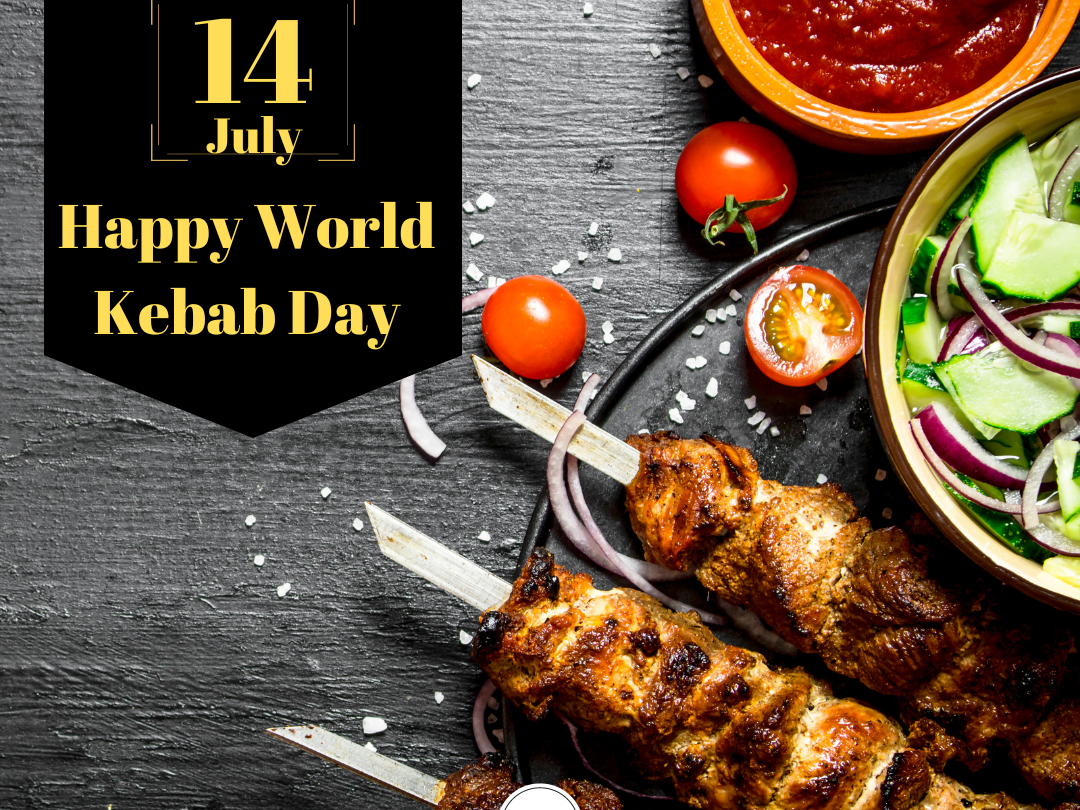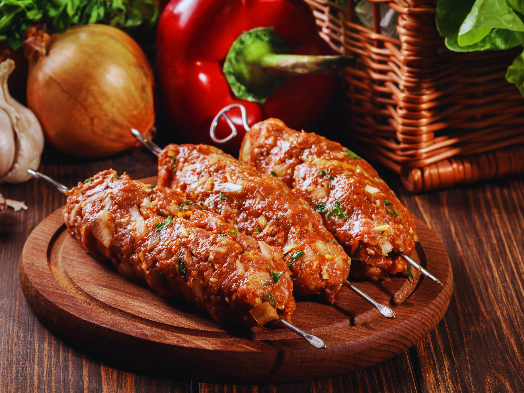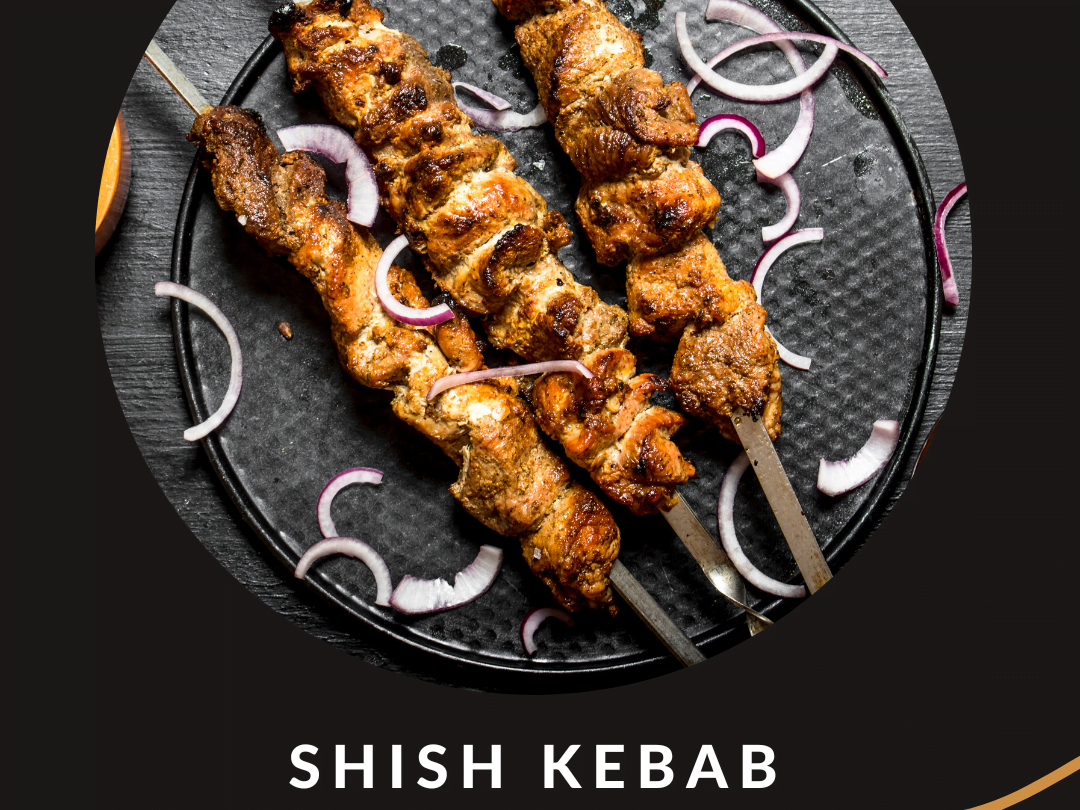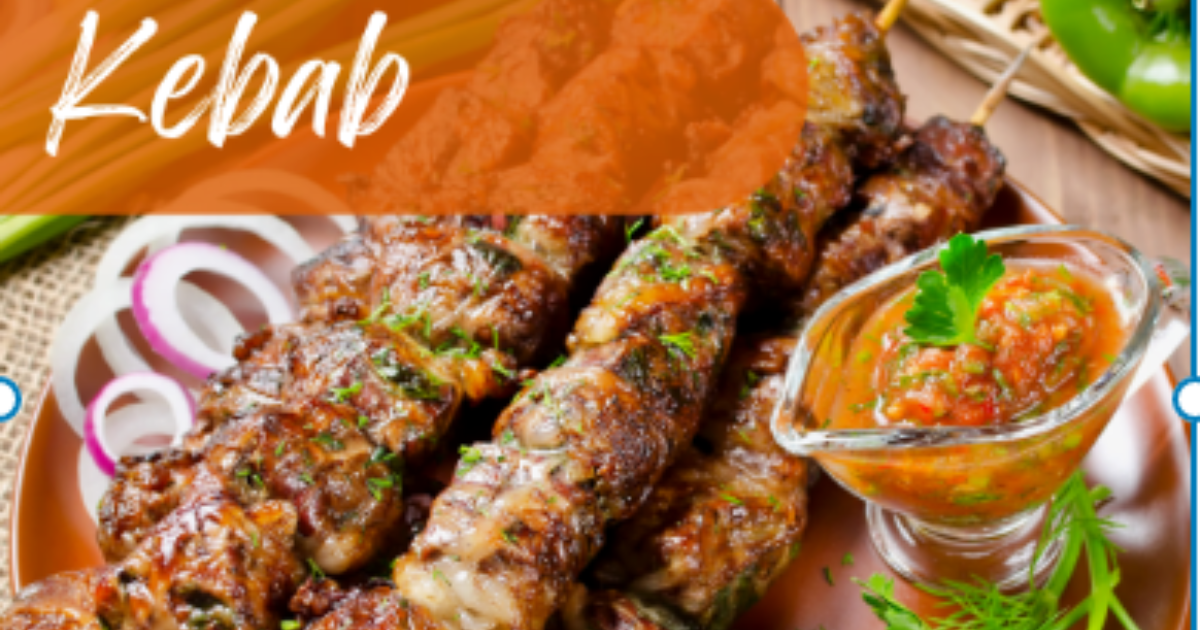The Ultimate Guide to Kebabs: A Mouthwatering Delight
Introduction
Are you ready to embark on a culinary journey filled with tantalizing flavors and succulent meats? Look no further than the humble kebab, a dish that has captivated food enthusiasts around the world. In this ultimate guide, we will explore the fascinating history, diverse variations, and irresistible appeal of kebabs. Get ready to indulge your taste buds and discover why kebabs are truly a mouthwatering delight.
1. World Kebab Day 2023


“There is a unique quality to kebabs, characterized by the combination of meat and vegetables threaded onto a bamboo skewer and grilled over hot coals. The tantalizing smoky flavor, the diverse range of seasonings, and the fusion of the carnivorous delight with the herbivore’s guilty pleasure create a common ground where everyone can gather.
World Kebab Day is a celebration of this delectable barbecue favorite, honoring its origins and providing us with the perfect excuse to indulge in as many kebabs as our hearts desire!
Discovering World Kebab Day World Kebab Day was established to commemorate this extraordinary culinary creation! Whether you savor a doner kebab after a night out with friends or relish in crafting your own shish kebabs, this day is dedicated to celebration.
Tonight’s menu has only one item—kebabs! Vegetarians need not worry, for there are plenty of vegetarian kebab options available. Over the years, many people have replaced the traditional meat with alternatives like tofu, cheese, and various vegetables.
The Historical Background of World Kebab Day
Kebabs boast a rich and venerable history, originating in the Middle East, where they began as simply seasoned grilled meat. In the Western world, we are particularly familiar with two distinct varieties—shish kebab and doner kebab.
Shish kebab, widely recognized and celebrated, represents a style prevalent in Asia. Typically crafted from lamb or beef, it occasionally includes swordfish or chicken. While we often see the meat and vegetables threaded together on a skewer, they were initially cooked separately.
On the other hand, the doner kebab, which commonly serves as the meat filling for gyros, takes a different form. It involves stacking layers of meat in an inverted cone shape and slowly roasting it by rotating it next to a vertical heat source. The outer layer is gradually sliced as it cooks and typically served in a pita bread, forming the renowned gyro. While doner kebabs have various culinary applications, we can’t help but wonder about other creative uses. There are also numerous other kebab varieties worth mentioning, such as Kebab Kenjeh, Kebab Halabi, Burrah, Kalmi, and Galouti, among others!”
2. The Origin Story of Kebabs
The origins of kebabs can be traced back to ancient times, with various theories suggesting different birthplaces. One theory suggests that kebabs originated in the Middle East, where they were cooked over an open fire by nomadic tribes. Another theory suggests that kebabs were first created in Central Asia, where the tradition of skewering meat and grilling it over an open flame was prevalent. Regardless of its exact origins, one thing is certain: kebabs have transcended borders and cultures, becoming a beloved culinary tradition worldwide.


3. Kebab: The Definition
A kebab is a dish made from small pieces of meat, fish, or vegetables that are marinated, skewered, and grilled to perfection. The word “kebab” is derived from the Arabic word “kebap,” which means “to roast.” The versatility of kebabs lies in the wide range of ingredients that can be used, making it a delight for both meat lovers and vegetarians alike. Whether you prefer tender chunks of lamb, succulent chicken, or flavorful vegetables, there is a kebab variation to suit every palate.
4. Types of Kebabs
Shish Kebab
Shish kebab is perhaps the most well-known and widely enjoyed kebab variation. It typically consists of marinated pieces of meat, such as lamb, beef, or chicken, skewered with colorful vegetables like bell peppers, onions, and tomatoes. The skewers are then grilled to perfection, resulting in a delightful combination of juicy meat and smoky flavors.


Doner Kebab
Originating from Turkey, doner kebab has gained immense popularity worldwide. It is made by stacking thin slices of seasoned meat, usually lamb or chicken, onto a vertical rotisserie. As the meat slowly cooks, thin slices are shaved off and served in a variety of ways, such as in pita bread with a selection of fresh vegetables and sauces.
Seekh Kebab
Seekh kebab is a popular kebab variation from the Indian subcontinent. It is made by mixing minced meat with a blend of aromatic spices, shaping the mixture onto skewers, and grilling them until they are beautifully charred. Seekh kebabs are often enjoyed with a side of mint chutney and naan bread.
Adana Kebab
Adana kebab hails from the southern region of Turkey and is named after the city of Adana. It is prepared using ground lamb or beef mixed with finely chopped onions, garlic, and an assortment of spices. The mixture is then molded onto flat metal skewers and grilled to perfection, resulting in a rich and flavorful kebab.
Tandoori Kebab
Tandoori kebabs are a specialty of Indian cuisine, particularly popular in the northern regions. The meat, often chicken, is marinated in a mixture of yogurt and tandoori spices, which imparts a vibrant red color and a distinct smoky flavor. The marinated meat is then cooked in a traditional clay oven, known as a tandoor, resulting in a tender and aromatic kebab.
Chapli Kebab
Chapli kebab is a beloved kebab variation originating from the Pashtun region of Pakistan and Afghanistan. It is made by mixing ground meat, typically beef or lamb, with a variety of spices, herbs, and onions. The mixture is shaped into flat, round patties and shallow-fried until golden brown. The unique blend of flavors and the crispy exterior make chapli kebabs a true delight.
Kofta Kebab
Kofta kebab is a versatile kebab variation found in Middle Eastern, South Asian, and Mediterranean cuisines. It is made by combining ground meat, such as lamb, beef, or chicken, with various herbs, spices, and breadcrumbs. The mixture is shaped into elongated meatballs or cylindrical shapes, skewered, and grilled to perfection. Kofta kebabs can be enjoyed on their own or in a wrap with fresh vegetables and sauces.
These are just a few examples of the diverse range of kebab variations found across different cultures and regions. Each type of kebab brings its own unique flavors and culinary traditions, making the world of kebabs an exciting and delicious one to explore.
5. Secrets to a Perfectly Grilled Kebab
Grilling the perfect kebab requires a delicate balance of flavors, textures, and cooking techniques. Here are some secrets to achieving a mouthwatering kebab every time:
- Marinating Magic: Marinating the meat or vegetables is essential to infuse them with flavor and ensure tenderness. Use a combination of spices, herbs, yogurt, lemon juice, and oil to create a tantalizing marinade that enhances the taste of your kebabs.
- Choosing the Right Cut: Selecting the right cut of meat is crucial for a tender and juicy kebab. Opt for cuts that are well-suited for grilling, such as lamb leg, beef sirloin, or chicken thighs. Trim excess fat and cut the meat into uniform pieces for even cooking.
- Don’t Skimp on Skewers: When it comes to skewering the meat and vegetables, invest in good-quality metal or bamboo skewers. Soak wooden skewers in water for at least 30 minutes before grilling to prevent them from burning.
- Mastering the Grill: Preheat your grill to medium-high heat before cooking the kebabs. Oil the grates to prevent sticking and maintain the right temperature throughout the grilling process. Turn the skewers occasionally to ensure even cooking and avoid charring.
- Timing is Everything: Cooking times vary depending on the type and size of the kebabs. Monitor the cooking process closely and use a meat thermometer to ensure that the meat reaches the desired level of doneness. Overcooking can result in dry and tough kebabs, so aim for a juicy and succulent texture.
- Basting Brilliance: Basting the kebabs with marinade or a flavorful glaze while grilling adds an extra layer of taste and moisture. Brush the kebabs with the basting sauce during the last few minutes of cooking to avoid burning and enhance the overall flavor profile.
Mastering these secrets will elevate your kebab-grilling game, ensuring that each bite is a burst of deliciousness that will leave your guests craving for more.
6. Marinades and Seasonings for Kebabs
The key to truly flavorful kebabs lies in the marinades and seasonings used. Here are some popular options that will take your kebabs to the next level:
- Classic Mediterranean: Create a marinade with olive oil, lemon juice, minced garlic, dried oregano, and a sprinkle of salt and pepper. This marinade works wonders for lamb, chicken, and vegetable kebabs, infusing them with the bright and fresh flavors of the Mediterranean.
- Indian Spice Blend: For an aromatic Indian twist, combine yogurt, ground cumin, coriander, turmeric, paprika, ginger, garlic paste, and a pinch of chili powder. This vibrant marinade pairs exceptionally well with chicken and lamb kebabs.
- Tandoori Delight: Recreate the flavors of a traditional tandoori kebab by mixing yogurt, tandoori masala spice blend, paprika, ground cumin, ginger, garlic paste, and a squeeze of lemon juice. Marinate your choice of meat or paneer (Indian cottage cheese) in this vibrant mixture for a truly authentic taste.
- Teriyaki Twist: For an Asian-inspired marinade, combine soy sauce, brown sugar, minced garlic, grated ginger, sesame oil, and a dash of rice vinegar. This sweet and savory blend works wonders with chicken, beef, or shrimp kebabs, giving them a deliciously sticky glaze.
Feel free to experiment with different combinations of herbs, spices, and sauces to create your signature marinade. The key is to let the kebabs marinate for at least a few hours or overnight to allow the flavors to penetrate the meat or vegetables thoroughly.
7. The Art of Skewering
Skewering is a crucial step in kebab preparation, as it ensures even cooking and easy handling. Here are some tips to master the art of skewering:
- Choosing the Right Skewers: Opt for sturdy metal skewers or soak wooden skewers in water for at least 30 minutes before using them. Soaking wooden skewers prevents them from burning or charring excessively during grilling.
- Uniformity is Key: Cut your meat, fish, or vegetables into uniform pieces to ensure consistent cooking. This allows all the ingredients on the skewer to reach their optimal level of doneness simultaneously.
- Alternate Ingredients: Thread the ingredients onto the skewers in a thoughtful and visually appealing manner. Alternate between meat, vegetables, and even fruits to create an enticing kebab presentation.
- Leave Space: Leave a small gap between each ingredient on the skewer to allow heat and smoke to circulate evenly, promoting thorough cooking and enhancing the smoky flavors.
- Handle with Care: When grilling the kebabs, use long-handled tongs to turn them gently. This prevents the ingredients from falling off the skewers and helps maintain their shape.
By following these skewering techniques, you’ll create kebabs that not only taste incredible but also look stunning on the plate.
8. Side Dishes and Sauces to Complement Kebabs
No kebab feast is complete without a selection of delicious side dishes and sauces. Here are some popular accompaniments that pair perfectly with kebabs:
- Fresh Salads: Serve a refreshing salad with vibrant greens, juicy tomatoes, crisp cucumbers, and tangy dressings. A classic Greek salad with feta cheese, olives, and a lemon-herb vinaigrette complements Mediterranean-style kebabs beautifully.
- Flavorful Rice: Prepare fragrant rice dishes to serve alongside your kebabs. Options like saffron-infused Persian rice or aromatic biryanis add depth and complexity to the meal.
- Warm Flatbreads: Offer a selection of warm flatbreads, such as pita bread, naan, or lavash, to wrap the kebabs in. The soft and pillowy texture of the bread creates a delightful contrast with the grilled meat and vegetables.
- Yogurt-Based Sauces: Prepare cooling yogurt-based sauces like tzatziki (made with yogurt, cucumber, garlic, and herbs) or raita (made with yogurt, grated cucumber, mint, and spices). These sauces add a creamy and tangy element that complements the smoky flavors of the kebabs.
- Pickled Delights: Introduce tangy and acidic flavors with pickled vegetables or condiments. Pickled onions, gherkins, or even spicy kimchi can provide a delightful contrast to the rich and savory kebabs.
The combination of these side dishes and sauces will elevate your kebab experience, offering a variety of tastes and textures to enjoy alongside the grilled delights.
9. Kebabs Around the World
Kebabs have transcended borders and become a global culinary phenomenon. Let’s explore some regional variations of kebabs from around the world:
- Middle Eastern Delights: Middle Eastern kebabs are known for their bold flavors and tender textures. From the juicy Shish Tawook in Lebanon to the aromatic Persian Chelow Kebab, Middle Eastern kebabs offer a diverse range of tastes and cooking techniques.
- Turkish Treasures: Turkey is home to a rich kebab tradition, with iconic dishes like Adana Kebab, Shish Kebab, and the famous Doner Kebab. These kebabs are characterized by their succulent meat, bold spices, and the use of traditional cooking methods.
- Indian Varieties: In India, kebabs are a beloved part of the cuisine, offering a myriad of flavors and cooking styles. From the spicy and smoky Tandoori Chicken to the melt-in-your-mouth Galouti Kebab, Indian kebabs showcase the country’s rich culinary heritage.
- Greek Charms: Greek kebabs, known as Souvlaki, are a popular street food delicacy. Marinated chunks of meat, usually pork or chicken, are grilled to perfection and served with pita bread, tzatziki sauce, and a variety of fresh vegetables.
- Persian Elegance: Persian kebabs, such as Koobideh and Barg, are renowned for their exquisite flavors and presentation. These kebabs often feature marinated meat, aromatic saffron, and a touch of Persian spices, resulting in a truly regal dining experience.
These are just a few examples of the diverse kebab variations found around the world. Each region brings its unique flavors, cooking techniques, and cultural influences to create kebabs that are a true reflection of their culinary heritage.
10. Categories of Kebabs
Kebabs can be categorized into the following categories:
- Meat Kebabs: This category includes kebabs made primarily with different types of meats such as lamb, beef, chicken, pork, or even seafood like fish and shrimp. Examples include shish kebabs, doner kebabs, seekh kebabs, and kofta kebabs.
- Vegetable Kebabs: These kebabs are made using a variety of vegetables, either individually or in combination. Common vegetables used in vegetable kebabs include bell peppers, onions, tomatoes, zucchini, mushrooms, and eggplant.
- Mixed Kebabs: Mixed kebabs combine both meat and vegetables on a skewer, offering a flavorful combination of both. These kebabs are often marinated together to enhance the overall taste.
- Seafood Kebabs: This category includes kebabs made specifically with seafood, such as fish kebabs, shrimp kebabs, or scallop kebabs. Seafood kebabs can be enjoyed with a variety of seasonings and marinades.
- Regional Kebabs: Kebabs can vary across different regions, each having their unique styles and flavors. Some examples include Turkish kebabs, Indian kebabs, Middle Eastern kebabs, and Persian kebabs. Each region brings its own traditional spices, marinades, and cooking techniques to create distinct kebab varieties.
- Vegetarian Kebabs: These kebabs are specifically designed for vegetarians and vegans. They utilize plant-based ingredients such as tofu, tempeh, seitan, paneer (Indian cheese), or a combination of vegetables and legumes to create delicious alternatives to meat-based kebabs.
- Grilled Kebabs: This category encompasses kebabs that are traditionally grilled over hot coals or an open flame. Grilling adds a smoky flavor and charred texture to the kebabs, enhancing their taste.
- Skewer-less Kebabs: While kebabs are commonly prepared on skewers, there are variations where the ingredients are shaped into patties or balls and cooked without skewers. Examples include Turkish Adana kebabs and Lebanese kafta kebabs.
These categories showcase the versatility of kebabs, offering a wide range of options to suit various tastes, dietary preferences, and cultural influences.
11. Health Benefits of Kebabs
Kebabs can be a nutritious and healthy choice when prepared with the right ingredients and cooking methods. Here are some health benefits associated with enjoying kebabs:
- Protein Power: Kebabs, especially those made with lean meats like chicken or turkey, are an excellent source of high-quality protein. Protein is essential for building and repairing tissues, supporting muscle growth, and maintaining a healthy immune system.
- Vitamin and Mineral Boost: Kebabs that incorporate a variety of vegetables provide a range of essential vitamins and minerals. Bell peppers, onions, tomatoes, and other colorful vegetables offer antioxidants, fiber, and beneficial micronutrients.
- Portion Control: Kebabs are often served in skewered portions, which can help with portion control. By including a balanced mix of protein and vegetables, kebabs can be a satisfying and well-portioned meal option.
- Grilled, Not Fried: Grilling kebabs is a healthier cooking method compared to deep-frying. Grilling allows excess fat to drip away from the kebabs, resulting in a lower calorie content and reduced consumption of unhealthy fats.
- Customizable Ingredients: Kebabs offer versatility, allowing you to choose ingredients that align with your dietary preferences. Whether you follow a low-carb, gluten-free, or vegetarian diet, kebabs can be customized to suit your needs.
As with any dish, it’s important to practice moderation and choose high-quality ingredients when enjoying kebabs as part of a balanced diet.
12. Common Kebab Myths Debunked
There are some misconceptions surrounding kebabs that deserve to be debunked. Let’s address a few common myths:
Myth 1: Kebabs are always unhealthy: While kebabs can be unhealthy if made with fatty meats, excessive oils, or high-calorie sauces, they can also be a nutritious choice when prepared with lean proteins, fresh vegetables, and wholesome ingredients.
Myth 2: Kebabs are difficult to make at home: While kebabs may seem daunting to make at home, they are actually quite simple and versatile. With the right ingredients and a few grilling techniques, you can easily create delicious kebabs in your own kitchen.
Myth 3: Kebabs are only made with meat: While meat kebabs are popular, there are numerous vegetarian and seafood options available. Vegetable kebabs, tofu kebabs, or even shrimp kebabs are excellent alternatives for those with different dietary preferences.
Myth 4: Kebabs are always spicy: While some kebabs incorporate spices for flavor, not all kebabs are spicy. You can adjust the level of spice according to your taste preferences or choose milder seasonings to suit your palate.
It’s important to approach kebabs with an open mind and explore the wide range of options available. With creativity and an understanding of the ingredients used, you can enjoy kebabs in a way that aligns with your health goals and taste preferences.
13. How to Make Kebabs at Home
Making kebabs at home is a rewarding experience that allows you to tailor the flavors and ingredients to your liking. Here’s a simple step-by-step guide to creating delicious kebabs in your own kitchen:
Ingredients:
- 500 grams of boneless chicken breasts, cut into bite-sized pieces
- 1 bell pepper, cut into chunks
- 1 red onion, cut into chunks
- 2 tablespoons of olive oil
- 2 cloves of garlic, minced
- 1 teaspoon of paprika
- 1 teaspoon of ground cumin
- 1 teaspoon of ground coriander
- Salt and pepper to taste
- Skewers (metal or soaked wooden skewers)
Instructions:
- In a bowl, combine the olive oil, minced garlic, paprika, cumin, coriander, salt, and pepper. Mix well to create a marinade.
- Add the chicken pieces to the marinade, ensuring they are well-coated. Cover the bowl and let the chicken marinate in the refrigerator for at least 1 hour, allowing the flavors to infuse.
- Preheat your grill or grill pan to medium-high heat.
- Thread the marinated chicken, bell pepper chunks, and onion chunks onto the skewers, alternating between ingredients.
- Lightly brush the grill grates with oil to prevent sticking. Place the skewers on the grill and cook for approximately 8-10 minutes, turning occasionally, until the chicken is cooked through and the vegetables are tender.
- Once cooked, remove the skewers from the grill and let them rest for a few minutes before serving.
- Serve the kebabs with your favorite side dishes, sauces, and accompaniments.
Feel free to experiment with different ingredients and seasonings to create your own signature kebab recipe. Whether you’re grilling indoors or outdoors, homemade kebabs are a delicious and satisfying meal option that will impress your family and friends.
Conclusion
Kebabs are a culinary delight that brings together flavors, cultures, and traditions from around the world. From the sizzling grills of the Middle East to the vibrant street food stalls of India, kebabs have captured the hearts and palates of food enthusiasts everywhere.
In this ultimate guide, we explored the fascinating history of kebabs, delved into the diverse types of kebabs found across different regions, and uncovered the secrets to grilling the perfect kebab. We also discussed the health benefits of kebabs, debunked common myths, and provided tips for making kebabs at home.
So, whether you’re planning a backyard barbecue, looking for a quick and delicious dinner option, or simply craving the mouthwatering flavors of kebabs, use this guide to embark on a culinary adventure that will leave you wanting more.
Indulge in the succulent meats, vibrant vegetables, and tantalizing marinades that make kebabs a truly irresistible delight. Get creative with your flavors, experiment with different ingredients, and savor each bite of these grilled masterpieces.
Now, go forth and explore the world of kebabs, impress your friends and family with your grilling skills, and let the aroma of smoky goodness fill your senses. Happy kebab-ing!
Kebab FAQ’s
Are kebabs always spicy?
Not necessarily. While some kebabs incorporate spices for flavor, not all kebabs are spicy. You can adjust the level of spice according to your taste preferences or choose milder seasonings to suit your palate.
Can I make vegetarian kebabs?
Absolutely! Vegetarian kebabs can be made using a variety of vegetables, tofu, paneer (Indian cottage cheese), or even plant-based meat substitutes. The possibilities are endless when it comes to creating flavorful vegetarian kebabs.
Can I bake kebabs instead of grilling them?
Yes, baking kebabs is an alternative cooking method if you don’t have access to a grill. Preheat your oven to 400°F (200°C) and place the skewers on a lined baking sheet. Bake for approximately 20-25 minutes, or until the kebabs are cooked through
How long should I marinate the kebabs?
It’s best to marinate the kebabs for at least 1 hour to allow the flavors to penetrate the meat or vegetables. For even more intense flavor, you can marinate them overnight in the refrigerator.
Can I freeze kebabs for later use?
Yes, you can freeze kebabs for later use. Prepare the kebabs as usual, but don’t grill them. Instead, place them on a baking sheet and freeze until firm. Once frozen, transfer the kebabs to a freezer-safe bag or container and store them for up to 3 months. When ready to cook, thaw the kebabs in the refrigerator overnight and then grill or bake them as desired.
What are some popular sauces to serve with kebabs?
There are numerous sauces that pair well with kebabs. Some popular options include tzatziki (a yogurt and cucumber sauce), mint chutney, tahini sauce, barbecue sauce, or a squeeze of lemon or lime juice. Experiment withdifferent sauces to find the perfect accompaniment for your kebabs.
What’s the difference between a kebab and a kabob?
Kabob with a “Bob” is a delicious dish enjoyed by people from energetic countries like Iran or Armenia, while Kebab or Kabab (spelled with two “a”s) is loved in Arabic-speaking nations such as Lebanon or Syria.
What is the American version of a kebab?
There are some variations between the two. Since it was first brought to the United States by Greek immigrants, it is mainly referred to as Gyros.



1 thought on “The Ultimate Guide to Kebabs: A Mouthwatering Delight”